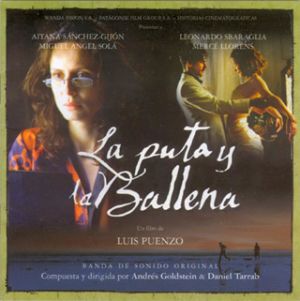************************************************************** EDITOR’s RECOMMENDATION November 2004 **************************************************************
La Puta y la Ballena
Music composed by Andrés Goldstein & Daniel Tarrab
Performed by members of the Orquestas Filarm ónica y Sinfónica Nacional de la República Argentina
Bandoneón - Nestor Marconi
Also includes three tangos composed by Julian Plaza, Miguel Bucino, Francisco De Caro / Mario Gomila
You Made Me Love You composed by Armstrong/Venable, arranged by Goldstein/Tarrab
Available on Acqua Records AQ057
Running time: 60.51
Gourmet Musical

See also:
- Some Who Lived
- World Soundtrack Awards nominations
- Official website for La Puta y la Ballena
Andrés Goldstein & Daniel Tarrab are a composing team based in Buenos Aires. The last time they were featured on Film Music on the Web was for the Chandos release of their excellent score to the Steven Spielberg produced Some Who Lived documentary in the Broken Silence series of documentaries about the Holocaust. La Puta y la Ballena is a film with less of a profile in the English speaking world, with no date yet set for a UK release. The film is however available on a Spanish Columbia Tristar region 2 DVD.
Not yet having seen the film (whose title translates as The Whale and the Whore) what I can say about it is that is a romantic drama – and judging from the trailer and stills in the CD booklet, a fairly erotic one – set in the past and present, in Argentina and in Spain during that country's Civil War. The impression one gets is of something along the lines of The English Patient and Land and Freedom meeting Malèna and Betty Blue.
The album is divided between tangos and symphonic romantic writing, some of which features the Bandoneón playing of Nestor Marconi, giving the whole a distinctly Latin colouration. There is no action or suspense writing, the score concentrating entirely on the romantic, tragic aspects of the story, the approach being highly evocative in a tradition which might encompass modern John Barry, Ennio Morricone and Gabriel Yared (the first and last of the four films I cite above were of course scored by the latter composer). That said, the music proves rather more characterful, melodically memorable and moving than anything either Barry or Yared have given the screen of late.
The piano and string arrangement of the title music has a pure, graceful quality which suggests reflections back over time and a calm, bittersweet resignation which is especially poignant. It is also a good tune – something all too rare in current film scoring. 'En el tren' suggests suspense with its opening bars, but quickly turns to more playful, carefree moods, leading to the carefree ragtime of 'You Made Me Love You' and the lightest part of the album – the lilting 'La IIeganda' and a pair of enchanting tangos. The remainder is essentially a score for string orchestra, woodwind, piano, harp and bandoneón, an instrument capable here of expressing considerable tenderness, nostalgic and regret, as well as more vibrant dance moods.
The main romantic themes are given numerous variations – a solo piano introducing 'Matilde La iniciacion' would not have been out of place in 1940's Hollywood – yet always hold the interest. Elsewhere the orchestra swells and there is no doubt this is old fashioned cinema romance in its finest modern reincarnation, which is to say tender and moving without drowning in phoney sentimentality. Morricone fans in particular may appreciate this fine music making.
If one is to find a fault it might only be with the rather rapid end to the disc, which does bring an hour of most enjoyable music to a somewhat abrupt halt. Perhaps in the film a song plays at this point, but if so it has not been included on the album.
Gary Dalkin
41/2
To download 14 of the 28 tracks in MP3 format and see a video clip from the film please go to http://www.swingmusica.com/laputaylaballena/
Composer Daniel Tarrab contacted me from Buenos Aires, noting that through the score has been nominated for a World Soundtrack Award, because of the low budget and profile of the film compared to the Hollywood blockbusters which it is competing with, people have not had the opportunity to hear the score. The decision has therefore been taken to put 14 of the cues from the album on-line to allow the score to be heard.
"We don't have unbelievable budgets for film music nor a film music tradition. Still we are in love with making things happen... Our soundtrack, La puta y la ballena was released by a tiny little record label but performed from our gut by Buenos Aires Symphony Orchestra and lovingly mastered at Bernie Grundman Mastering by Pat Sullivan (Jurassic Park / Shindler's List - and countless hits). We do things in an old and romantic fashion. We found a crossing point between the Tango and Orchestral textures."
Return to Index